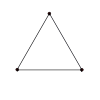Shannon multigraph
In the mathematical discipline of graph theory, Shannon multigraphs, named after Claude Shannon by Vizing (1965), are a special type of triangle graphs, which are used in the field of edge coloring in particular.
- A Shannon multigraph is multigraph with 3 vertices for which either of the following conditions holds:
- a) all 3 vertices are connected by the same number of edges.
- b) as in a) and one additional edge is added.
More precisely one speaks of Shannon multigraph Sh(n), if the three vertices are connected by  ,
,  and
and  edges respectively. This multigraph has maximum degree n. Its multiplicity (the maximum number of edges in a set of edges that all have the same endpoints) is
edges respectively. This multigraph has maximum degree n. Its multiplicity (the maximum number of edges in a set of edges that all have the same endpoints) is  .
.
Examples
- Shannon multigraphs
-

Sh(2)
-

Sh(3)
-

Sh(4)
-

Sh(5)
-

Sh(6)
-

Sh(7)
Edge coloring

According to a theorem of Shannon (1949), every multigraph with maximum degree  has an edge coloring that uses at most
has an edge coloring that uses at most  colors. When
colors. When  is even, the example of the Shannon multigraph with multiplicity
is even, the example of the Shannon multigraph with multiplicity  shows that this bound is tight: the vertex degree is exactly
shows that this bound is tight: the vertex degree is exactly  , but each of the
, but each of the  edges is adjacent to every other edge, so it requires
edges is adjacent to every other edge, so it requires  colors in any proper edge coloring.
colors in any proper edge coloring.
A version of Vizing's theorem (Vizing 1964) states that every multigraph with maximum degree  and multiplicity
and multiplicity  may be colored using at most
may be colored using at most  colors. Again, this bound is tight for the Shannon multigraphs.
colors. Again, this bound is tight for the Shannon multigraphs.
References
- Fiorini, S.; Wilson, Robin James (1977), Edge-colourings of graphs, Research Notes in Mathematics 16, London: Pitman, p. 34, ISBN 0-273-01129-4, MR 0543798
- Shannon, Claude E. (1949), "A theorem on coloring the lines of a network", J. Math. Physics 28: 148–151, MR 0030203.
- Volkmann, Lutz (1996), Fundamente der Graphentheorie (in German), Wien: Springer, p. 289, ISBN 3-211-82774-9.
- Vizing, V. G. (1964), "On an estimate of the chromatic class of a p-graph", Diskret. Analiz. 3: 25–30, MR 0180505.
- Vizing, V. G. (1965), "The chromatic class of a multigraph", Kibernetika 1965 (3): 29–39, MR 0189915.
External links
| Wikimedia Commons has media related to Shannon multigraphs. |
- Lutz Volkmann: Graphen an allen Ecken und Kanten. Lecture notes 2006, p. 242 (German)